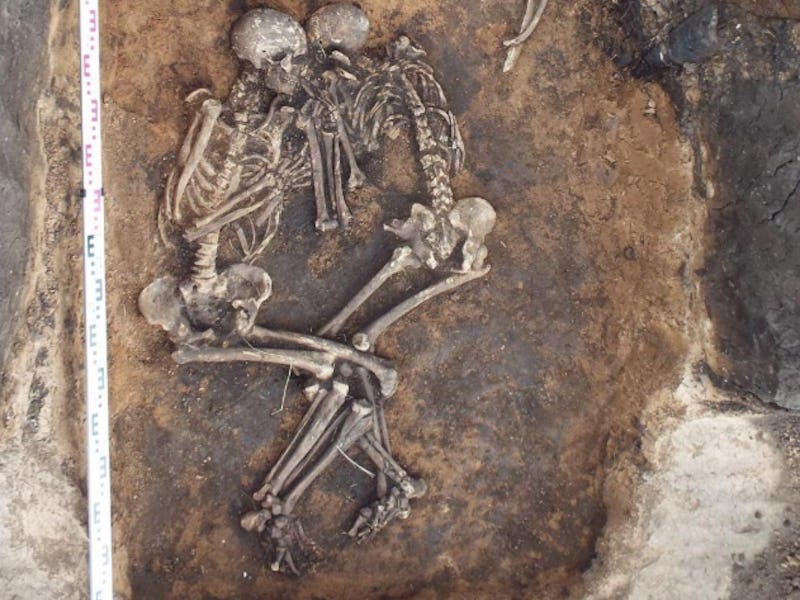Russian Skeletons Show the Bubonic Plague Has Killed People for 4,000 Years
Scientists sequence the oldest genome linked to the disease.

Hidden in the bones of ancient humans lies evidence of diseases that continue to distress people today. Recently, the examination of two 3,800-year old skeletons revealed the presence of a Yersinia pestis strain, famously the bacterium that causes plague. This strain is now the oldest of its kind sequenced to date, and suggests that the devastation that is the bubonic plague has a Bronze Age origin.
The discovery, published Friday in Nature Communications, pushes back the proposed age of the bubonic plague by 1,000 years. It also adds to the understanding of a disease that is still reported between one and seven times per year in the United States, despite its more ancient reputation: In the U.S. 80 percent of plague cases have been in the bubonic form. Although it’s been present throughout much of recorded history — it was the drive behind some of humanity’s deadliest pandemics including the Justinian Plague and the Black Death — the origin and age of the disease have remained largely a mystery.
“Contrary to previous studies suggesting that Y. pestis was unable to cause disease during that time, we provide evidence that bubonic plague has been affecting humans for at least the last 4,000 years,” study co-author Maria Spyrou tells Inverse.
The triangle marks the examined burial site in the Samara region of Russia.
Spyrou is an ancient DNA researcher at the Max Planck Institute for the Science of Human History. For her Ph.D., she’s been focused on studying the evolutionary history of plague for the past four years: In this particular project, she and her team turned to human remains from the Bronze Age to hunt for it. Overall the researchers analyzed nine individuals from tombs at a site within the Samara region of Russia. Two of the individuals, buried within the same grave, were found to be infected with Y. pestis at the time of their death.
“We have recently come to realize that the Bronze Age was a period of massive population turnovers in Eurasia, and human movements during this time may have facilitated or have been facilitated by the spread of infectious disease,” explains Spyrou. “The Eurasian Steppe, where our studied material comes from, seems to have been a key region to the human migrations and transformations which happened during that time.”
Double burial of two plague victims in the Samara region, Russia.
Spyrou and her team reconstructed the Y. pestis genomes from these remains, an accomplishment which, they write, “suggests that the full ability for flea-mediated transmission causing bubonic plague evolved more than 1,000 years earlier than previously suggested.” They propose that during the Bronze Age there were several Y. pestis lineages, some of which persist today. The genome sequenced here was likely an ancestral strain to later epidemics, like the Black Death.
Y. pestis strands of a similar age have been found before, but in those studies, the genomes didn’t show the genetic signatures that are needed for the bubonic form of the disease. Specific characteristics are what makes this plague efficiently transmit from fleas, to rodents, to humans and other mammals. If the strain lacks genetic components that makes it possible for fleas to contract and pass it, then there’s no bubonic plague.
Spyrou explains that Y. pestis diverged from a mild bacterium called Yersinia pseudotuberculosis which lives predominantly in the soil, then later acquired the ability to transmit through fleas of the gain of certain genes (like one that colonizes the flea’s gut) and the loss of others (like another gene that makes the bacterium toxic to fleas).
Microscopic closeup of *Y. pestis*.
It still exists today because of this ability to jump from creature to creature.
“Interestingly, plague is not a disease that is adapted to humans — it’s not a human disease,” says Spyrou. “Y. pestis is rather a bacterium that lives and replicates predominantly among wild rodents. The fact that it lives predominantly among rodents is one of the main reasons why it is so difficult to eradicate.”
That it infects humans, Spyrou elaborates, is an unlucky situation mostly fueled by chance. Now it’s obvious that humans have been unlucky in this matter for longer than ever realized.